In a time when traditional advertising is seen as “pervasive, obnoxious, and intrusive,” you may have joined the masses of marketers switching to a content-based strategy—one that focuses on providing value and engaging with audiences in more meaningful ways.
And as you may have already discovered, it takes a village to execute a proper content marketing strategy.
So if your next plan of action is to build a content marketing team that lets you scale your content creation, and ideally your company, keep reading.
In this blog post, I’ll explain why you should create a content marketing team, the pros and cons of hiring your own team or going with an agency, as well as how to build your own team from scratch, so you can scale your marketing efforts and make more sales.
Why Create a Content Marketing Team?
There are a few important benefits that come with building a content marketing team.
For starters, the content marketing approach itself has a lot to offer. It helps you connect with audiences by providing value and increasing engagement. Ad blockers are now more popular than ever (30% of internet users reportedly use one), so a content marketing team can help you reach your audience when traditional banner ads just don’t deliver.
Having a content team can help you nail that approach while keeping in mind long-term company goals. Having people dedicated to brainstorming, producing, and distributing high-value content helps you deliver brand experiences that make a bigger impact on audiences.
While building a team may seem like a huge cost, it likely makes sense for your bottom line: content marketing efforts can cost up to 62% less than traditional marketing campaigns while delivering up to three times more leads.
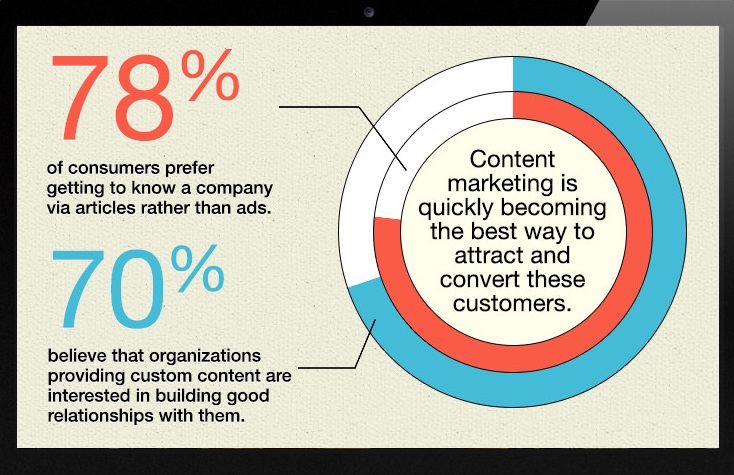
78% of consumers prefer getting to know a company through valuable articles than traditional ads. Source
Hiring Your Own Team Versus a Third Party
One question you might have wrestled with is whether you should hire your own team, or a third-party content marketing agency instead? There are pros and cons to each, of course, so I’ll discuss them and then give my personal recommendation.
Content Marketing Agency
Pros
- It May be cheaper than hiring individual employees for the team
- Agencies already have teams of professionals in their field to do most content marketing responsibilities, saving you time in recruiting and onboarding
Cons
- Because they aren’t your employees, you might have issues dealing with deadlines, as agencies typically have several clients and projects besides yours
- Not all content marketing agencies are created equal: some agencies have no experience in your niche and might not be able to deliver as in-depth content as you’d like
In-House Content Marketing Team
Pros
- Have a deep understanding of your company’s goals, products, culture, and competition
- Can give updates on short notice
- All their working hours are dedicated to your company’s projects
Cons
- Takes time and resources to hire and onboard
- May be prone to tunnel vision, or only seeing things from a certain perspective
Given these pros and cons, which one should your company choose?
My recommendation: co-sourcing.
What this means is you can hire key players to be full-time, in-house employees, while outsourcing certain roles and deliverables to agencies or freelancers.
This is the way to get the best of both worlds, by keeping the best talent as full-time employees while getting an agency’s talent to fill in the gaps.
Steps to Create a Content Marketing Team
Ready to start building your own content marketing team? Here are seven steps to getting started.
1. Choose Between In House vs. Remote
Because advancements in technology have allowed content teams the luxury of working remotely, you might have found yourself debating between letting employees work in-house or remotely.
One advantage of letting employees work in-house is being able to get updates as quickly as possible while fostering better relationships within the company. When people are able to see each other at work, it’s easier to brainstorm.
On the other hand, remote working can save you the overhead costs of maintaining an office. And because many candidates in the labor market today value the opportunity to work from anywhere, you may get access to better talent and retain employees longer.
In my content marketing agency, I’ve built a completely remote content marketing team with people from all over the world. To manage my business better, my team and I communicate regularly via Skype or Slack, collaborate on project management tools, and set clear deadlines and goals.
Here are a few questions to guide you as you decide whether to take your team in house or keep them remote:
- Can you afford office rent for your entire content marketing team?
- Do your team members live in the same city?
- Do you need to meet your content marketing team regularly (at least once a week)?
If you answered yes to most of these questions, you may benefit from keeping your team in-house.
Some factors that will, of course, require a remote team are:
- Where your talent is located. Are they based all over the world or in different cities?
- Is your remote team made up of freelancers?
- How well can team members collaborate digitally instead of through in-person meetings? If your team consists of digital nomads, for example, they’re more likely to be comfortable doing video conference meetings, responding to project updates via text, and using real-time collaboration tools like Google Suite or Asana.
2. Develop Your Team’s Structure
To guide your hiring and onboarding process, create a team structure that assigns different goals for your content marketing team members. A solid team structure can help inform different roles and responsibilities.
Consider what sub-teams you’ll need to report to different leaders and managers in your company. Make sure to keep the structure clear and organized, so that you don’t risk overlap of responsibilities and causing internal confusion.
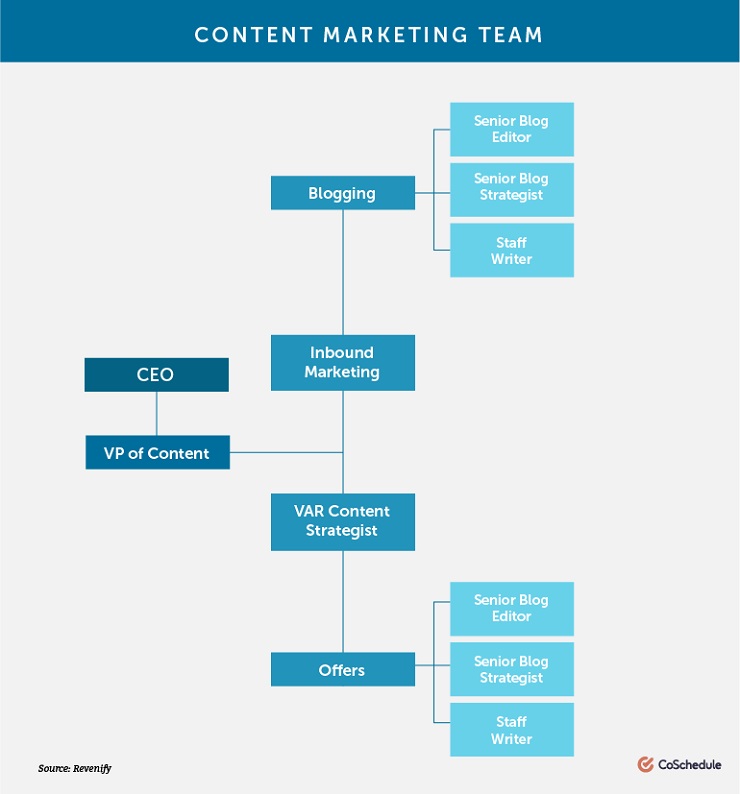
An example of a very simple modern content marketing team structure. Yours may vary depending on your industry and company goals.
When you’re building your content marketing team for the first time, the Content Marketing Institute recommends a T-shaped professional model to start. This model suggests hiring people who have basic knowledge across a horizontal T but have comprehensive knowledge in one area, or the vertical T (see below).
So when you’re hiring people to fill out roles on your team and assigning them to sub-teams, you want them to know how each sub-team operates. For example, a content writer has basic knowledge about social media promotion, visual branding, SEO, and like, but needs room to apply their own expertise—writing in-depth articles that provide value to readers and audiences.
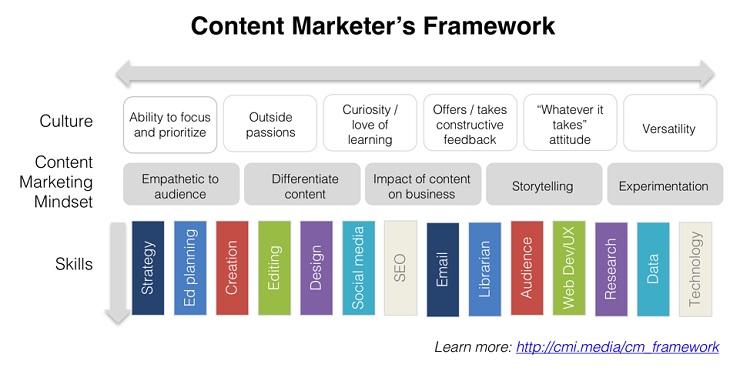
Another thing you can consider as you plot out your structure: if you’re only just starting your team or lack the budget to hire all at once, prioritize your managing editor, content writers, graphic designers, SEO specialists, analytics experts, and web developers before filling out more specialized positions.
Need a Marketing Plan? We got the best ready for you.
3. Make a List of the People You Need
After determining the structure of your content marketing team, you’ll want to list the specific people to go under each sub-team. These people will then each be assigned a specific role that helps them contribute to your content marketing goals.
It’s important to keep roles as distinct as possible. When you give people the space to do one function well, you can expect better results than if you require everyone to wear multiple hats.
Below, I’ve included a list of people you may want to employ for your content marketing team.
But an important note first: Depending on your budget and goals, you may not be able to employ one specific person to handle each of these tasks. This list assumes an ideal scenario, where one person manages one role. Sometimes, you will meet brilliant minds who can assume two, maybe even three roles, especially when you’re just starting out and can’t afford talent for each of these.
That said, here are different content marketing team members you’ll want to consider when building your team:
Chief Marketing Leader
You might already be in this role either as a Chief Marketing Officer or as a company founder.
Whether or not this is an open role you want to fill in, the chief marketing leader is the person who aligns your marketing units and sales or business development units. This person should know the goals and targets of the company sales team so that they can make sure the marketing team—whose essential goal is to support sales—creates strategies and content that supports this goal.
The chief marketing leader also consistently keeps up with other company leaders. They essentially make sure that the entire content marketing team can help move the company in the direction they want to go, using on-point marketing campaigns and strategies.
Managing Editor
A managing editor’s role is to oversee all the content being produced by the marketing team, from long-form blog posts to videos and other published work by the company. They make sure the volume of published content stays generally stable throughout the quarter.
The managing editor stays on top of the editorial calendar and directly manages team editors and contributors. They essentially are the liaison between content strategy and content creation, making sure both original and curated content serve the overall marketing goals of the company.
SEO and Analytics Expert
An expert in search engine optimization (SEO) and analytics can be key in making sure your content marketing pieces are optimized. This person is in charge of keyword research to shape the content calendar and SEO-related tests and experiments.
An SEO and analytics expert is also responsible for staying on top of data that can inform future marketing strategies and tactics. They might recommend to the managing editor to create more long-form posts about a particular topic if they find that said topic generates the most traffic and leads, or they can suggest creating lead magnets based on popular content.
This role is often outsourced or taken on as a consultant. But you may want to hire one in-house in order to train your team or to make sure your company keeps a data-first approach.
Editors
If your content—from blog posts to social media posts to newsletters—is riddled with typos and grammatical errors, this could make readers and subscribers doubt the quality of your content, regardless of how well-researched or even well-written it is.
Editors are the backbone of your content marketing tactics. They make sure everything that comes out is excellent and ready for audiences.
Depending on your desired team structure, you can have in-house editors reporting to the managing editor. Or you can hire freelance editors to do proofreading and polishing work per project. But if you plan on creating content consistently, it’s best to hire at least one editor in-house.
Content Writers
Writers are your people doing the bulk of the day-to-day content creation, especially for blog posts. In a perfect world, you have writers who are experts in subject matters related to your industry.
So if you’re a real estate company, you’ll want writers who have experience creating content related to that niche. These writers might not necessarily have any direct experience in the industry, such as being real estate agents or brokers.
But if they’ve written content for similar companies in your niche, you can be sure they’ve done enough research to have extensive knowledge about the field.
Multimedia Creators
Multimedia designers and creators are an important element in your content marketing team. These people create audio-visual content, graphics, branded collateral, and more to support your content marketing efforts.
They should have a thorough understanding of your brand’s visual language to make content easier for audiences to consume. They’re able to create beautifully-designed infographics, short videos, GIFs, and lead magnets that supplement the written word.
Multimedia creators may include graphic artists, video editors, or even photographers if your brand wants 100% original photos.
Content Distribution Teams
Last but not least, some important roles you can consider hiring once you’ve scaled are people to handle distribution of your content. Roles like email marketers and social media managers help you get your content out there and in front of a wider audience.
It’s possible to outsource these tasks to a marketing agency, but for companies who want the most control over their distribution channels, you can hire dedicated people to fill these roles.
—
You may definitely have more people to consider for roles in your content marketing team, but consider this list a good place to start. Once you’ve covered the basic functions and assigned someone to each, you can think about other roles and expand from there.
4. Have the Right Tools in Place
To effectively manage your team and monitor your campaigns and goals, invest in the right tools. Use content management systems, such as WordPress or Joomla, for editors and writers, IDEs (Integrated Developer Environment) for web developers like Visual Studio Code or Bluefish, graphic and video-creation tools for multimedia creators like Adobe products or Final Cut Pro, and the like.
I mentioned previously that in my own company, I use Slack and Skype to manage communication between my team and myself, but we also use Asana for managing our content calendar and seeing which stage every project is at.

Asana can be a great tool for a content calendar.
5. Create an Onboarding Strategy
Once you’ve hired your team, it’s time to onboard them. As a best practice, create onboarding documents that you can store and send to leaders and managers to help them train new hires.
My company uses onboarding documents for new content writers. Some resources I give them are checklists to go through before submitting articles, as well as the main goals of our company.
To ease new hires in, you can send them these documents you’ve prepared and go through them together.
Here are a few practices to follow when onboarding new hires:
- Pre-onboarding, have necessary documents such as work contracts signed and filed.
- Create your onboarding document. This board template by Trello can serve as a great start, where you can help new hires remember things you may have oriented them during their first few days. It includes things like who to talk to for specific concerns and even reiterates company goals.
- Plan out each new hire’s first day on the job. You may want to introduce them to the rest of your content team, inform them to who they report, and then help them jump into their first project as part of the team.
- After their first week, send an onboarding survey that can help you determine whether they’re clear in their new position and how they’re doing in your company so far.
Related: The Ultimate Content Marketing Strategy for Startups
6. Craft Your Content Marketing Playbook
Next, your content marketing team needs to have some kind of playbook so that all your content has a unified look and sound. Here are the elements you need to craft your own content marketing playbook.
Style Guide
A style guide helps inform designers and editors how to present your content and brand. These are typically visual elements, such as infographics and videos, but can also be applied to elements like blog post formatting.
Adobe has a comprehensive style guide that tells designers how to use its logo, the specific colors it uses across materials, as well as the kinds of images it uses across its website and brand collateral.
To create your own style guide, refer to this complete post by Canva.
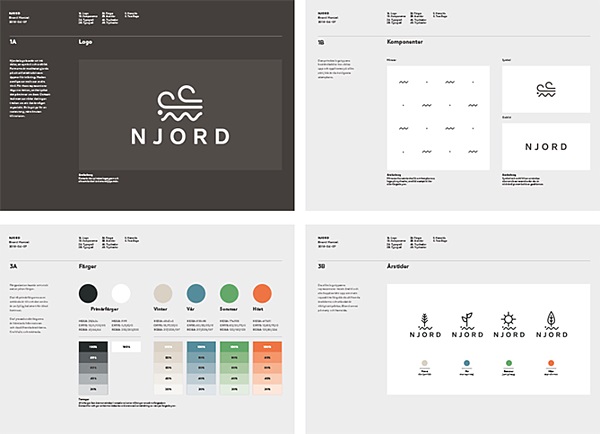 Example of a brand style guide for visual unity.
Example of a brand style guide for visual unity.
Brand Voice
Even if you have a team of diverse writers, it’s important to have a clear and consistent brand voice. This sets the tone for how writers ought to craft their pieces. Should they be formal or casual? Are they witty or serious?
MailChimp has a complete style guide hub that walks employees through writing goals and principles, formatting, and other writing mechanics that appear on branded MailChimp content, including blog posts and newsletters.
The brand voice guide is useful not only for staff writers but also for informing contributors as well. For example, here are Foundr’s contributor guidelines that tell you their brand voice for guest article pitches.
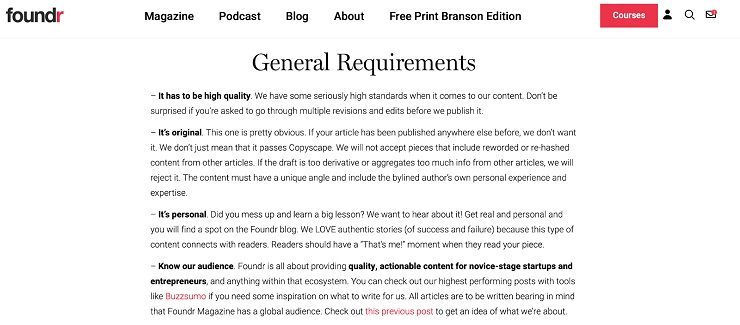
Distributing Content
Finally, your playbook can be even more beneficial by including a distribution guide. Inside this guide is your plan to disseminate content, be it promoting a new blog post, boosting a new social media ad, or even sharing a new ebook. Essentially, this is how you make sure your content is seen by your audience. This guide can also help shape newsletters and social media posts, and may even include different websites and publications for link building.
Inside your distribution guide, you may include:
- Content-type (ebook, blog post, social media graphic, etc.)
- Copy to accompany the content type
- Channels on which to promote the content type
- Publish date
- Promotion date on each channel
- Dates to send to influencers or thought leaders
- Dates for paid boosting
Key Takeaways
If you’ve been on the fence about building a content marketing team, I hope this guide helps to clarify your next steps and guide you along your way. From figuring out how your team can operate down to the specific members of your team, be sure to plan for success.
Over time, you’ll soon have the content marketing team that scales your brand and your business, increasing customer engagement and boosting sales.

























